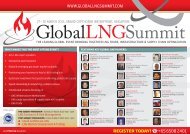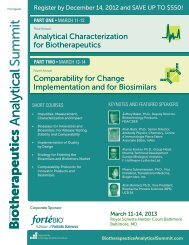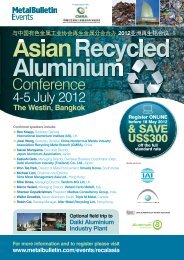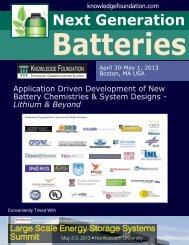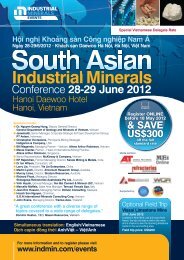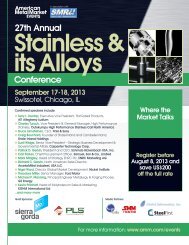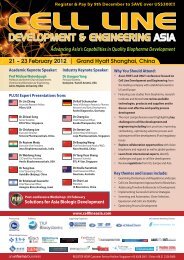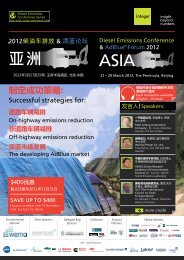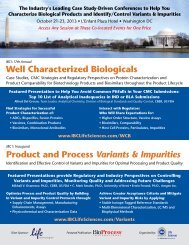Full Conference Details Inside
Full Conference Details Inside
Full Conference Details Inside
You also want an ePaper? Increase the reach of your titles
YUMPU automatically turns print PDFs into web optimized ePapers that Google loves.
1:40<br />
1:45<br />
2:15<br />
2:45<br />
Thursday, October 11, 2012 (continued)<br />
Cell Culture Recovery & Purification<br />
Effect of the Cell Culture Environment<br />
on Product Quality<br />
Chairperson’s Remarks<br />
Gary J. Welch, Director, Process Science,<br />
Abbott Bioresearch Center<br />
Engineering a Glycosylated <strong>Full</strong>-Length IgG<br />
Antibody: Bypassing Glycosylation, Developing<br />
Novel Effector Functions and Enhancing Potency<br />
UNPUBLISHED<br />
DATA<br />
In IgG molecules, removal of the glycan at Asn297 abolishes<br />
binding to FcγRs and effector functions mediated by<br />
leukocytes. We have developed a robust screening platform<br />
for engineering aglycosylated full length IgG with various FcγRs<br />
selectivity. A set of Fc engineered versions of aglycosylated antibody<br />
with unique or improved effector functions have been generated and<br />
will be discussed.<br />
Sang Taek Jung, Ph.D., Research Associate, Staff Scientist,<br />
Department of Chemical Engineering,<br />
The University of Texas at Austin<br />
Optimizing Productivity and Product Quality<br />
of a Commercial Cell Culture Process for<br />
a High Demand mAb Product<br />
CASE STUDY<br />
UNPUBLISHED<br />
DATA<br />
This case study will highlight challenges and key<br />
achievements in developing a high titer cell culture<br />
process under short timelines. Initial platform process<br />
bioreactor studies yielded unexpectedly low titers, but a two-fold<br />
improvement was obtained through mimicking the uncontrolled<br />
pH profile observed in shake flasks. Several product quality<br />
challenges were also addressed, including mitigating sequence<br />
variants and modulating charge variants.<br />
Melissa Mun, M.S., Engineer II, Late Stage Cell Culture,<br />
Genentech, Inc.<br />
A Scale-Down Model Qualification Case Study<br />
for QbD Cell Culture Process Characterization<br />
Cell culture process characterization studies for a protein<br />
production process were performed using a scale-down<br />
model. A Quality by Design (QbD) approach was taken<br />
in order to improve overall process understanding, with the final<br />
outcome being both univariate and multivariate acceptable ranges<br />
for each parameter tested. However, applicability of these study<br />
results to the manufacturing scale depends on the validity of<br />
the scale-down models that have been used. In this particularly<br />
complex case study, both small and pilot scale models were<br />
qualified. Evaluation of some product quality attributes required<br />
further downstream processing through scale-down purification<br />
models. As a result, qualification of the cell culture model<br />
ultimately relies on qualification with the purification scale-down<br />
model as well. The way the models were applied depends both<br />
on the product quality attribute being evaluated and the unitoperation<br />
being characterized. Our scale-down model qualification<br />
approach will be presented and challenges related to applying<br />
scale-down results to manufacturing scale will be discussed.<br />
Angela Meier, B.Sc., Engineer I, Late Stage Cell Culture Process<br />
Development, Genentech, Inc.<br />
CASE STUDY<br />
UNPUBLISHED<br />
DATA<br />
Streamlining Downstream Processing to<br />
Improve Cost and Time to Clinic<br />
Chairperson’s Remarks<br />
Uwe Gottschalk, Ph.D., Vice President, Purification Technology,<br />
Sartorius Stedim Biotech, Germany<br />
Manufacturing High Concentration mAb<br />
Formulations using Ultrafiltration / Diafiltration<br />
Monoclonal antibody therapeutics have traditionally been<br />
delivered using intravenous (IV) administration. Companies are<br />
now increasingly developing high concentration formulations of<br />
monoclonal antibody therapeutics to allow subcutaneous (SC)<br />
administration. New UF/DF systems can be designed to minimize<br />
hold-up volume and enhance mixing in the recycle tank, allowing for<br />
formulation at high concentrations. Utilizing legacy UF/DF systems<br />
for SC formulation can lead to many challenges. Challenges will be<br />
discussed, and a case study will be presented on implementation<br />
of high concentration formulation on a UF/DF commercial scale<br />
system not originally designed for SC formulation.<br />
Stephen Hohwald, Engineer, Purification Development,<br />
Genentech, Inc.<br />
Exploiting Online Refractometry for Improved<br />
Ultrafiltration Development and Manufacturing<br />
Engineering Operation Control<br />
CASE STUDY<br />
CASE STUDY<br />
UNPUBLISHED<br />
DATA<br />
Accurate targeting of high protein concentration Drug<br />
Product formulations has become a challenge within<br />
biological manufacturing arenas via traditional absorbance methods<br />
and process control techniques. The work presented here will<br />
demonstrate the application of inline refractometry to provide<br />
real-time concentration measurements for enhanced ultrafiltration<br />
process monitoring and control. Data will be presented from<br />
pilot and clinical manufacturing systems. In summary, inline<br />
probes demonstrated >96% concentration accuracy up to 150g/L.<br />
Additional applications for inline refractometry will be discussed for<br />
Biologics processing.<br />
Nickolas Brings, MBA, Process Engineer,<br />
Global Engineering and Facilities, Biogen Idec<br />
Robustness and Efficiency of Two Column<br />
Purification Process<br />
Timothy Iskra, M.S., Principal Scientist, Pfizer Inc.<br />
UNPUBLISHED<br />
DATA<br />
Vaccine and Complex Biologics<br />
Development and Production<br />
Chairperson’s Remarks<br />
Hari Pujar, Ph.D., Director, External Process Development,<br />
Merck & Co., Inc.<br />
QbD for Vaccines: From Regulatory Relief to<br />
Design for Manufacturing<br />
Due to the complexity of vaccines manufacturers are working<br />
together with regulators to appropriately apply QbD approaches<br />
to vaccine development and control. Many companies, however,<br />
have realized the value of these enhanced methods in developing<br />
a robust manufacturing process and in helping to ensure product<br />
quality through a carefully established control strategy. This talk<br />
will highlight QbD approaches which help assure an ample supply<br />
of quality vaccines to the public.<br />
Timothy Schofield, Managing Director, Arlenda USA<br />
Implementing Vaccine QbD<br />
Robert Repetto, M.S., MBA., Research Fellow, External Affairs,<br />
Pfizer BioTherapeutics Pharmaceutical Sciences;<br />
Chair, PDA Single-Use System Task Force<br />
Presentation TBA<br />
17 To Register, Call: (800) 390-4078 • Fax: (941) 365-0104 • E-mail: reg@ibcusa.com • www.IBCLifeSciences.com/BPI



